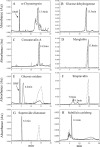Identifying kinetically stable proteins with capillary electrophoresis
- PMID: 20091769
- PMCID: PMC2867027
- DOI: 10.1002/pro.336
Identifying kinetically stable proteins with capillary electrophoresis
Abstract
Unlike most proteins, which are in equilibrium with partially and globally unfolded conformations, kinetically stable proteins (KSPs) are trapped in their native conformations and are often resistant to harsh environment. Based on a previous correlation between kinetic stability (KS) and a protein's resistance to sodium dodecyl sulfate (SDS), we show here a simple method to identify KSPs by SDS-capillary electrophoresis (CE). Control non-KSPs were fully denatured by SDS and formed protein:SDS complexes that exhibited similar mobility in CE. In contrast, KSPs bound fewer SDS molecules, and showed a very different migration time and peak pattern in CE, thereby providing some insight about the structural heterogeneity of SDS:protein complexes and the relative KS of the various proteins.
Figures


Similar articles
-
Identifying the subproteome of kinetically stable proteins via diagonal 2D SDS/PAGE.Proc Natl Acad Sci U S A. 2007 Oct 30;104(44):17329-34. doi: 10.1073/pnas.0705417104. Epub 2007 Oct 23. Proc Natl Acad Sci U S A. 2007. PMID: 17956990 Free PMC article.
-
Quantifying the kinetic stability of hyperstable proteins via time-dependent SDS trapping.Biochemistry. 2012 Jan 10;51(1):100-7. doi: 10.1021/bi201362z. Epub 2011 Dec 9. Biochemistry. 2012. PMID: 22106876
-
Structural basis of protein kinetic stability: resistance to sodium dodecyl sulfate suggests a central role for rigidity and a bias toward beta-sheet structure.Biochemistry. 2004 Sep 7;43(35):11248-54. doi: 10.1021/bi0491898. Biochemistry. 2004. PMID: 15366934
-
Capillary electrophoresis in presence of sodium dodecyl sulfate and a sieving medium.Electrophoresis. 1997 Nov;18(12-13):2239-42. doi: 10.1002/elps.1150181214. Electrophoresis. 1997. PMID: 9456038 Review.
-
Capillary electrophoresis of proteins for proteomic studies.Electrophoresis. 1999 Oct;20(15-16):3116-21. doi: 10.1002/(SICI)1522-2683(19991001)20:15/16<3116::AID-ELPS3116>3.0.CO;2-0. Electrophoresis. 1999. PMID: 10596819 Review.
Cited by
-
Metastability of papain and the molecular mechanism for its sequential acid-denaturation.Protein J. 2011 Mar;30(3):184-93. doi: 10.1007/s10930-011-9319-z. Protein J. 2011. PMID: 21404103
-
Size separation of proteins by capillary zone electrophoresis with cationic hitchhiking.Electrophoresis. 2011 Oct;32(20):2884-92. doi: 10.1002/elps.201100114. Epub 2011 Sep 22. Electrophoresis. 2011. PMID: 21948216 Free PMC article.
References
-
- Plaza Del Pino IM, Ibarra-Molero B, Sanchez-Ruiz JM. Lower kinetic limit to protein thermal stability: a proposal regarding protein stability in vivo and its relation with misfolding diseases. Proteins. 2000;40:58–70. - PubMed
-
- Kelly JW, Colón W, Lai Z, Lashuel HA, Mcculloch J, Mccutchen SL, Miroy GJ, Peterson SA. Transthyretin quaternary and tertiary structural changes facilitate misassembly into amyloid. Adv Protein Chem. 1997;50:161–181. - PubMed
-
- Manning M, Colón W. Structural basis of protein kinetic stability: resistance to sodium dodecyl sulfate suggests a central role for rigidity and a bias toward β-sheet structure. Biochemistry. 2004;43:11248–11254. - PubMed
Publication types
MeSH terms
Substances
LinkOut - more resources
Full Text Sources

